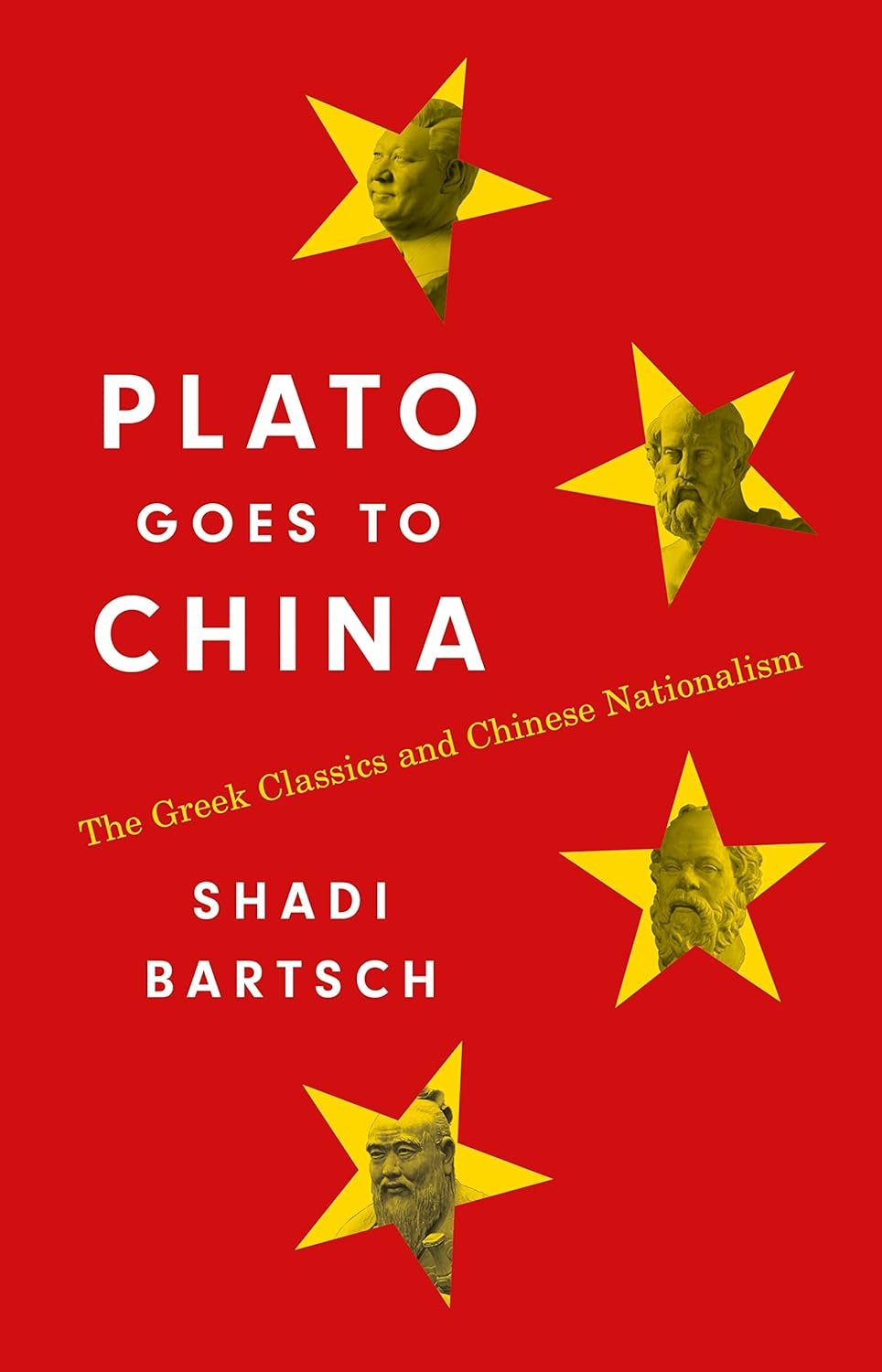The University of Chicago academic Shadi Bartsch’s book explores the role of the Greek philosophical tradition in Chinese political thought
by Christopher Giofreda
Plato Goes to China originated in a series of lectures by the author, Shadi Bartsch, a classics professor and historian at the University of Chicago. Bartsch sought to uncover the West’s assumptions about the Greek tradition. The present volume proceeds orthogonally to that larger aim, as we see the Chinese national project rediscovering ancient texts on their own. Bartsch’s careful research ought to be of interest to philosophers, rhetoricians, and historians of the domestic and international variety. The book has three main ideas: how the Chinese used Ancient Greece to understand their own country and develop a politics; how they reconnoitered the West through the Greek tradition; and how views of Greek texts changed after the 1989 Tiananmen Uprising.
Chapter one sets us down in the AD 1600s, long before the Opium Wars, in a time before the West mattered to China. Bartsch implies that we see the Sino-Western relationship at its most unconstructed—though a band of Jesuits, under Matteo Ricci, had been working to learn Mandarin and ingratiate themselves. Ultimately Ricci is invited to the royal court in his capacity as a scientist, and the shared part of our history formally begins.
Like future Straussians, the Jesuits learned “to borrow Confucian terminology and concepts to ‘translate’ what they were saying into issues and categories that sounded familiar to the court.” These games of language are captivating, as we see Ricci and co. trade their society’s material advantages into cultural and religious capital. They make Epictetus and Catholicism convenient in a way that presages what the later Chinese will do for their own audiences. Bartsch’s own chapter summary is irresistible: “Catholics citing pagan Stoics to show the Chinese court and its mandarins that this new religion, Christianity, was largely Confucian, but also incorporated the figure of Jesus and an anthropomorphized God” (175).
Chapter two takes us to the decade after the Tiananmen Uprising. Athenian democracy and Aristotle’s politics were no longer cultural bogeymen. However, the reform movement, as it developed, became top-down and nationalistic. The means of cultural rejuvenation—or perhaps it is better considered a creation— would be post-Marxist, and the Greeks would serve this purpose. Bartsch calls this “a nationalist discourse, but not a democratic one” (52). Classic Western texts were read in ways that worked against earlier reform movements: the pro-democracy, pro-science May 4th Movement of 1919, with its emphasis on “Mr. Science” and “Mr. Democracy” as well as the pro-democracy values expressed during the Tiananmen Uprising. Chinese academia still interprets the Greek classics in two ways: the first consciously emulates Western hermeneutics and the other remains Confucian and socialist. Chinese scholars in the second tradition find it convenient to attack Athenian democracy as a sham, critiqued in its own time by the likes of Thucydides.
Professor Shadi Bartsch, the author of Plato Goes to China: The Greek Classics and Chinese Nationalism (Princeton University Press, 2023); screenshot taken from the University of Chicago’s Division of the Humanities website.
Chapter three, “Thinking with Plato’s Noble Lie,” addresses more than the Kallipolis of Plato’s Republic. We see modern China’s conscious attempt to prove that their chosen governance is a naturally-occurring phenomenon. Plato’s big lie in the Republic was his attempt to tell citizens that they came from the earth and were of one blood, despite the rather unequal roles and/or shares in political power. But Bartsch asks how one does scholarship on “the big lie” without seeming to indict aspects of one’s culture found in the text (13).
The Western democrat finds much that is déclassé in Plato’s Republic—e.g., critiques of democratic governance and social mobility. Plato’s Kallipolis is “hierarchical” and “class-based” (84). However, the Chinese reader finds that all people in the City are unequal, which must strain credulity for a people raised under Communism. Nevertheless, scholars could certainly read around these inconveniences. The Confucian readers were able to justify their own elevated positions: Much as the rational soul guides its lesser parts, so did the philosopher kings do the same for the body politic.
But a practical difficulty presented itself. It is not so easy to launder a noble lie to a people who have Plato’s Republic on their bookshelves! The way that the lie itself had to be reshaped is one of the most interesting aspects of the book. Bartsch shares the case of Desmond Lee, the translator who believed that the so-called noble lie (gennaion pseudos) had to be recast as a banal national myth.
Chapter four, “Rationality and Its Discontents,” revisits the formative uprisings of May 4th, 1919, and Tiananmen Square, 1989. China underwent two philosophical reckonings brought on by exogenous events. The dissidents of May 4th envied the instrumental rationality of the West as found in the objects of its science. (Perhaps this is the continuation of the “scientific” opening brought by Ricci.) The crisis of Tiananmen Square in 1989 was read historically as well—this time through the May 4th rebellion itself. Elites were loath to accept an instrumental rationality that cut against traditional Chinese ethics.
Perhaps this split in rationality seems a bit too neat, but it became a formidable challenge to overcome thanks to the spread of Max Weber’s Protestant Work Ethic and the Spirit of Capitalism (1905). Weber’s idea of instrumental rationality was thought to be an antidote to the “sluggish Confucian economy” (109). However, this wasn’t the full story of Weber’s book. Chinese academics would have to weaken Weber’s caution about instrumental rationality if they wanted to harness its animating force. But the path to instrumental rationality was even more tortuous than rewriting Weber. Confucius was an almost insuperable barrier to instrumental rationality. Classical Chinese virtue was deliberately opposed to instrumental rationality—in that there was “no obvious relationship of morality to rational deliberation” but a sort of endless commitment to benevolence and humaneness (ren) (119). What could be more opposed to Socratic dialectic than the silence of the Daoist Zhuangzi? (120).
Chapter five, “A Straussian Interlude,” details how a cadre of Chinese intellectuals sought to reclaim antiquity. Leo Strauss (1899-1973) was a political philosopher whose interpretative scheme allowed public (exoteric) and private (esoteric) meanings. For Strauss, writers could speak truth to elite thinkers without upsetting the opinion of the broader population. In the 1990s, Chinese public opinion tended to be relativistic and nihilistic (131). Chinese Straussians worked against relativism and nihilism—and the lassitude that came with them—without seeming to do so. They found common cause with American Straussians like Allan Bloom, facing the same at home. However, Chinese Straussians took care not to be captured by other cultures.
Committed Straussians could open up a rhetorical frontier against whatever sapped the animating energy from Chinese culture. Perhaps the largest conduit for Strauss in China was the Hermes series, some 500 classics—including Western political theory—edited by the Straussian Liu Xiaofeng. These texts could prevent the culture from hurtling toward modernity—and the social ills that attended it. Barscht’s fifth chapter capably ties the book together. Her own desire to know antiquity on its own terms—detailed in the preface—is mirrored in Chinese intellectual culture. However, the tension of this chapter is whether Chinese Straussians ever really aspired to place Greek texts out of a hegemonic framework or whether they simply wanted to add one more convenient interpretation.
“Harmony for the World,” Bartsch’s sixth chapter, concerns the application of Confucian harmony to late twentieth-century China. At a government-sponsored function, a bureaucrat named Gu Mu ably summed up one vision of public life: 1) Technological change, while beneficial, required “diligently strengthen[ing] the building of culture,” 2) harmony had to occur between people and humankind to nature, 3) the cultural project means resisting the lure of new freedoms (147). Bartsch notes the emphasis on Confucian thought by party elites. Mao had severed the link to Confucian harmony, so the ethos of the pre-revolutionary philosophers had to be restored (or possibly remade). Confucius was going to be the referee in any tussle among economic, technological, and social tensions (149). This chapter will be valuable to rhetoricians since the praise of Confucianism is necessarily epideictic.
“Thoughts for the Present” concludes the book. Plato’s Republic endures as a way to posit a West in decline. That is, following Alfred North Whitehead, if the West is no longer a footnote to Plato, we must be too weak to sustain ourselves. At the same time, the love of Plato in China—to which they may be the heir apparent—allows them to identify with the West when it is convenient to do so. The Republic has become the means of merger or separation from the West— whatever is rhetorically savvy. Considering what Plato thought of rhetoric in Gorgias, one notes the conflict at the center of a reclamation of Plato.
The philosopher will have one bee in his or her bonnet by the end. We are not allowed to venture far beyond Aristotle’s Politics and Plato’s Republic. This makes sense given the author’s Straussian commitments. However, we never really see into the shadow these big works cast. We are left hoping the author will release another volume on, say, how the Chinese use the Phaedrus. The Symposium comes up in Ch. 5, but the esoteric reading (i.e. the reading of what was unsaid), via Strauss, does not quite allow us to access the thought of Chinese scholars themselves (since they were using techniques from an American.) However, this frustration did not spoil an otherwise excellent book.
Work cited
Bartsch, Shadi (2023) Plato Goes to China: The Greek Classics and Chinese Nationalism (New Jersey: Princeton University Press) ISBN: 9780691229591



